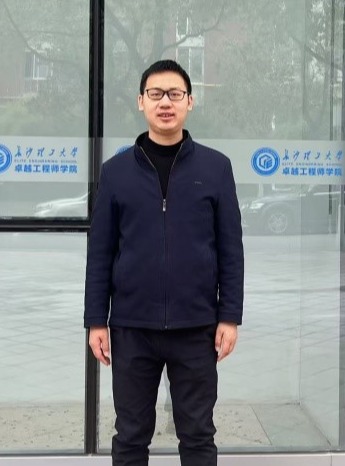 一、个人基本信息
一、个人基本信息
陈辉,男,中共党员,工学博士,副教授,湖南省力学学会理事。主要从事材料力学性能表征与失效机理分析等方面研究。先后主持国家自然科学基金、湖南省自然科学基金、湖南省教育厅科研项目、省部级重点实验室开放基金以及双一流建设项目等,并参与国家自然科学基金重点项目、面上项目等国家级课题多项。在《Acta Mater》、《Appl Math Model》、《Int J Mech Sci》、《中国科学》及《力学学报》等国内外权威期刊上发表论文40余篇,授权发明专利8项,参与制定国家标准1项。担任《《Int J Mech Sci》、《Mater Design》、《Measurement》等期刊审稿人及国家标准评审专家。主要负责《材料力学》、《实验力学》等课程教学工作,获校“年度优秀教师”,“优秀毕业生指导教师”等荣誉称号,主持湖南省普通高校教学研究与改革项目1项。
二、教育经历
2012.09-2019.06 西南交通大学力学与工程学院,固体力学,博士
2008.09-2012.06 西南交通大学力学与工程学院,工程力学,学士
三、主要研究方向
1. 无损/微损力学表征方法;
2. 先进材料跨尺度力学行为;
3. 服役结构或装备完整性评价。
四、主持或参与项目情况
1. 国家自然科学基金青年项目, 激光增材制造金属损伤机理及非均匀断裂性能的原位压痕研究, 2025-01 至 2027-12, 在研, 主持;
2. 国家自然科学基金重点项目, 面向服役安全的热端结构损伤容限可靠性设计理论与方法研究, 2023-01 至 2027-12, 在研, 主要参与;
3. 湖南省自然科学基面上项目, 选区激光熔化合金高温后力学性能的高通量压痕测试研究, 2025-01 至 2027-12, 在研, 主持;
4. 湖南省自然科学基金青年项目, 延性材料模量、强度与硬度的一体化压痕测试方法, 2021-01 至 2023-12,结题, 主持;
5. 教育厅优秀青年项目,钢结构焊接残余应力的微压痕数值模拟与测试方法,2020/09- 2023/8,结题,主持;
6. 国家自然科学基金面上项目,延性材料与裂纹构元的断裂理论及毫微测试方法研究,2019/01-2022/12,结题,主要参与;
7. 国家自然科学基金面上项目,基于延性材料RVE破断行为的结构完整性评价基础问题研究,2015/01-2018/12,结题,主要参与。
五、已发表的学术论文
[1] Chen H, Xiao J, Peng H, et al. A new method for predicting residual stress in light alloys using truncated conical indentation. International Journal of Pressure Vessels and Piping, 2025, 214: 105427.
[2] Meng Z, Chen H*, Peng H, et al. Evaluation method of uniaxial residual stress in metallic materials by spherical indentation[J]. Materials Today Communications, 2025, 42: 111370.
[3] Meng Z, Chen H*, Peng H, et al. A novel model to obtain equi-biaxial residual stress of metallic materials via instrumented spherical indentation[J]. Nondestructive Testing and Evaluation, 2024: 1-20.
[4] Chen H, Peng H, Cai L, et al. A novel combined dual-conical indentation model for determining plastic properties of metallic materials[J]. Journal of Materials Research and Technology, 2022, 20: 3241-3254.
[5] Fu Z, Chen H*, Peng H, et al. A novel model for obtaining both equi-biaxial and uniaxial residual stress of metallic materials by instrumented sharp indentation[J]. International Journal of Pressure Vessels and Piping, 2023, 203: 104942.
[6] Chen H, Fu Z, Chen D, et al. A unified sharp indentation method for obtaining stress-strain relations, strength and Vickers hardness of ductile metallic materials[J]. Materials Today Communications, 2022, 33: 104652.
[7] Chen H, Cai L X. An elastoplastic energy model for predicting the deformation behaviors of various structural components[J]. Applied Mathematical Modelling, 2019, 68:405-421.
[8] Chen H, Cai L X, Bao C. Equivalent-energy indentation method to predict the tensile properties of light alloys[J]. Materials & Design, 2019, 162:322-330.
[9] Chen H, Cai L X. Theoretical model for predicting uniaxial stress-strain relation by dual conical indentation based on equivalent energy principle[J]. Acta Materialia, 2016, 121: 181-189.
[10] Chen H, Cai L X. Unified elastoplastic model based on a strain energy equivalence principle[J]. Applied Mathematical Modelling, 2017, 52: 664-671.
[11] Peng Y., Cai L X, Chen H*, et al. A new method based on energy principle to predict uniaxial stress-strain relations of ductile materials by small punch testing[J]. International Journal of Mechanical Sciences, 2018, 138: 244-249.
[12] Peng Y, Cai L X, Chen H*, et al. A novel semi-analytical method based on equivalent energy principle to obtain J resistance curves of ductile materials[J]. International Journal of Mechanical Sciences, 2018, 148: 31-38.
[13] Chen H, Cai L X. Theoretical conversions of different hardness and tensile strength for ductile materials based on stress–strain curves[J]. Metallurgical and Materials Transactions A, 2018, 49(4): 1090-1101.
[14] Chen H, Cai L. A universal elastic-plastic model correlating load-displacement relation and constitutive parameters for typical testing components[J]. Results in Physics, 2019: 102230.
[15] Chen H, Cai L X. Unified ring-compression model for determining tensile properties of tubular materials [J]. Materials Today Communications, 2017, 13: 210-220.
[16] Chen H, Cai L X, Bao C. A novel model for determining tensile properties and hardness of steels by spherical indentations[J]. Strain, 2020: 12365.
[17] Chen H, Cai L X, Li C X. An elastic-plastic indentation model for different geometric indenters and its applications[J]. Materials Today Communications, 2020:101440.
[18] Peng Y, Cai L, Yao D, Chen H*, et al. A novel method to predict the stress-strain curves and J resistance curves of ductile materials by small samples[J]. International Journal of Pressure Vessels and Piping, 2019:172:48-55.
[19] Peng Y, Cai L X, Chen H*, et al. A theoretical model for predicting uniaxial stress-strain relations of ductile materials by small disk experiments based on equivalent energy method[J]. Transactions of the Indian Institute of Metals, 2019, 72(1): 133-141.
[20] Peng Y, Cai L X, Chen H*, et al. Application of a semi-analytical method that accounts for constraint effects in the determination of resistance curves of mode I cracked specimens[J]. Theoretical and Applied Fracture Mechanics, 2020,107: 102560.
[21] Liu Q, Cai L, Chen H*, et al. A novel test method based on small specimens for obtaining low-cycle-fatigue properties of materials[J]. Mechanics of Materials, 2019, 138: 103153.
[22] Liu X K, Cai L X, Chen H, et al. Semi-analytical model for flat indentation of metal materials and its applications [J]. Chinese Journal of Aeronautics, 2020, 33(12):3266-3277.
[23] Qi S, Cai L X, Bao C, Chen H, et al. Analytical theory for fatigue crack propagation rates of mixed-mode I–II cracks and its application[J]. International Journal of Fatigue, 2019, 119: 150-159.
[24] 陈辉,范中天,彭晖,等.预测金属材料拉伸性能的圆台形平面压入方法[J].工程力学,2024,41(11):207-216.
[25] 陈辉,蔡力勋,彭晖,等.幂硬化材料圆锥压入完整塑性区的应力分布模型[J].中国科学:物理学 力学 天文学,2023,53(01):95-104.
[26] 陈辉,傅作华,陈得良,等.基于维氏压入理论模型的材料塑性参数与硬度一体化预测方法[J].机械工程学报,2023,59(08):132-141.
[27] 陈辉,蔡力勋,彭晖.预测铝合金单轴力学性能的复合型双锥压入法[J].机械工程学报,2021,57(20):79-88.
[28] 李虎, 陈辉*, 彭晖, 等.TC17钛合金表面残余应力的点阵式维氏压痕测试[J].机械工程材料,2024,48(07):93-99.
[29] 陈辉, 蔡力勋, 包陈.双锥度压入的FAT迭代法获取材料的力学性能[J].核动力工程, 2015, 36(5): 101-104.
[30] 张志杰, 蔡力勋, 陈辉*, 包陈, 刘晓坤.金属材料的强度与应力-应变关系的球压入测试方法[J].力学学报, 2019,51(01):159-169.
[31] 张希润,蔡力勋,陈辉.基于能量密度等效的超弹性压入模型与双压试验方法[J].力学学报,2020,52(03):787-796.
[32] 贺屹, 蔡力勋, 陈辉*, 彭云强. 求解I型裂纹构元J积分的半解析方法[J].力学学报, 2018, 50(3): 579-588.
[33] 贺屹,蔡力勋,陈辉. 基于能量等效原理的K因子、柔度统一模型[J].机械工程学报, 2018,54(14):98-106.
[34] 尹涛, 蔡力勋, 陈辉, 姚迪. 基于毫小薄片试样获取材料应变疲劳性能的测试方法[J].机械工程学报, 2018, 54(10): 68-77.
[35] 尹涛,蔡力勋,陈辉, 姚迪. TA17合金薄片材料毫小试样疲劳性能研究.工程力学, 2018,35(11):206-215.
[36] 刘勤,蔡力勋,陈辉.用于薄片试样弹塑性应力-应变分析的半解析方法[J].航空学报,2018,39(11):90-101.
[37] 张志杰,郑鹏飞,陈辉,蔡力勋.基于能量等效原理的金属材料硬度预测方法[J].工程力学,2021,38(03):17-26.
[38] 于思淼, 蔡力勋, 姚迪, 包陈, 陈辉,等. 准静态条件下金属材料的临界断裂准则研究.力学学报,2018, 50(5): 1063-1080.
[39] 尹涛,蔡力勋,陈辉,包陈.利用小尺寸缺口试样测定延性材料的单轴本构关系[J].航空材料学报,2016,36(01):81-86.
[40] 陈辉,蔡力勋,包陈.基于小圆环试样获取金属材料单轴本构关系的FAT方法[J].应用数学和力学,2014,35(S1):136-140.
[41] 陈辉,蔡力勋,姚迪,包陈.基于小尺寸材料试验与有限元分析的耦合方法获取材料力学性能[J].机械强度,2014,36(02):187-192.
六、授权专利
[1] 蔡力勋, 陈辉, 刘晓坤, 包陈, 张志杰. 基于球、锥一体压头的材料等效应力-应变关系预测方法, 中国, 201810677841.4 [P]. 2022-4-29,
[2] 陈辉 ,蔡力勋, 包陈,尹涛. 圆环径向压缩能量预测材料单轴本构关系测定方法: 中国, 201510309391.X [P].2017-12-19.
[3] 蔡力勋,陈辉,包陈,刘晓坤. 圆球形压入预测材料单轴应力-应变关系测定方法: 中国, 201610023696.9 [P].2018-07-31.
[4] 蔡力勋,陈辉,彭云强. 双锥形压入预测材料单轴本构关系测定方法: 中国, 201610024076.7 [P].2018-05-22.
[5] 蔡力勋,陈辉. 圆柱形平头压入预测材料单轴本构关系的测定方法: 中国, 201610023839.6 [P].2018-07-31.
[6] 蔡力勋,陈辉. 一种基于圆锥形压头的已知材料残余应力测定方法, 201810706088.7 [P]. 2020-09-08.
[7] 彭云强,蔡力勋,陈辉,包陈,圆盘试样压缩获取材料单轴应力-应变关系的方法: 中国, 201610169980.7 [P].2018-06-19.
[8] 蔡力勋,彭云强,陈辉,刘晓坤. 小冲杆试验获取材料单轴应力-应变关系的方法: 中国, 201610606265.5 [P].2018-10-30.
七、其他成果与奖励
[1] 陈辉(10/15); 在役公路桥梁服役性能不中断交通精准诊评与快速提升关键技术, 中国公路学会科学技术一等奖, 2023.
[2] 蔡力勋, 包陈, 陈辉, 董莉, 李荣锋, 刘晓坤,等. 金属材料 压入试验强度、硬度和应力-应变曲线的测定[S].国家标准 GB 37782—2019.
[3] 蔡力勋, 陈辉, 包陈. 10000个科学难题•制造科学卷—“典型构元的力-变形弹塑性解析关系和测试方法”[M]. 科学出版社, 2018. pp. 1203-1205.